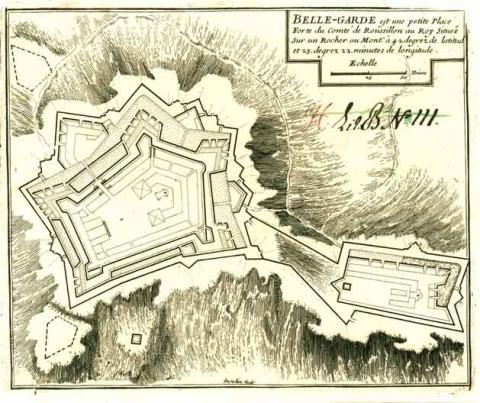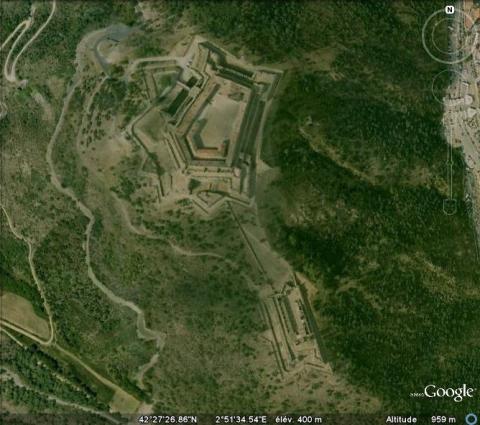Fort de Bellegarde
History and description
The Bellegarde hill (420 m. alt.) dominates the Perthus pass (271 m.) perched on the Franco-Spain border. The site has been occupied since the middle Ages, the objective being to take control of the pass. The presence of a tower has been confirmed since the 18th century, which was later encircled by a rectangular castle, including moat, built the following century. The village and the Perthus pass fell into French hands during the treaty of the Pyrenees of 1659. This switching of sovereignty did not immediately trigger any new constructions however. In March 1668, the Knight of Clerville, Commissioner-General of the fortifications, visited the site and deemed it important for the defence of the province of Languedoc. Shortly after he passed away, Bellegarde had its first French garrison installed, numbering fifty soldiers. This garrison had been in place for just one month when the castle was attacked by a group of Spanish troops; consisting of seven hundred infantry and three hundred cavaliers. The garrison repulsed this attack, however, which convinced Louvois, the War Minister under Louis XIV, to renovate the same in the interests of boosting defences.In 1669, Vauban proposed several improvements, the construction of which was interrupted in 1672 by the war of Holland and a Spanish siege in 1674. One sole construction, a lunette directed towards Spain, was completed before this siege. The Spanish attempted to short up the defences by adding a hornwork to the south, a ravelin next to the front of Panissars and a covered way, work on which was suspended when the territory passed back into French hands. The engineer Saint-Hilaire, in charge of the Roussillon fortifications, suggested finishing the construction but Louvois refused. However, the concepts of what should be restructured were fleshed out. In 1679, Vauban concluded a project for the fort, which was then approved by Louis XIV. This fort consisted of a higher section (situated to the north), which was an irregular pentagonal fortress with five bastions, three ravelins and three ramparts; the lower part (situated to the south) was made up of a detached hornwork, which was linked to the fort by a covered way. This project was accepted by Louvois and completed.
Current state
The fort de Bellegarde is completely preserved. Visiting is possible anytime between June and September, contact the tourist office for more information.
Fort de Bellegarde
Fort de Bellegarde
42° 27' 33" N, 2° 51' 31" E
Type
fort
Engineers
Sébastien le Prestre de Vauban, Jacques de Borelly de Saint-Hilaire, Lorenzo Possi
Department
Pyrénées-Orientales
Region
Occitanie
Bibliography
- AYATS (A.), Les fortifications de Vauban. Découverte guidée en pays catalan, Canet, 2007.
- AYATS (A.), Louis XIV et les Pyrénées catalanes de 1659 à 1681 : frontière politique et frontières militaires, Montpellier, 2002, (thèse de doctorat déposée à Montpellier en 1990).
- AYATS (A.), « Le fort de Bellegarde » in Vauban et ses successeurs dans les Pyrénées, Paris, 2003, p.341-347.
- FAUCHERRE (N.), La route des fortifications en Méditerranée, Paris, 2007.

